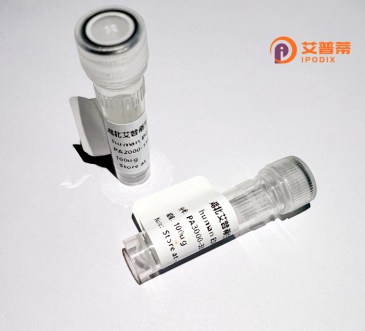
| 纯度 | >90%SDS-PAGE. |
| 种属 | Human |
| 靶点 | FCHSD2 |
| Uniprot No | O94868 |
| 内毒素 | < 0.01EU/μg |
| 表达宿主 | E.coli |
| 表达区间 | 1-740aa |
| 氨基酸序列 | MQPPPRKVKV TQELKNIQVE QMTKLQAKHQ AECDLLEDMR TFSQKKAAIE REYAQGMQKL ASQYLKRDWP GVKADDRNDY RSMYPVWKSF LEGTMQVAQS RMNICENYKN FISEPARTVR SLKEQQLKRC VDQLTKIQTE LQETVKDLAK GKKKYFETEQ MAHAVREKAD IEAKSKLSLF QSRISLQKAS VKLKARRSEC NSKATHARND YLLTLAAANA HQDRYYQTDL VNIMKALDGN VYDHLKDYLI AFSRTELETC QAVQNTFQFL LENSSKVVRD YNLQLFLQEN AVFHKPQPFQ FQPCDSDTSR QLESETGTTE EHSLNKEARK WATRVAREHK NIVHQQRVLN DLECHGAAVS EQSRAELEQK IDEARENIRK AEIIKLKAEA RLDLLKQIGV SVDTWLKSAM NQVMEELENE RWARPPAVTS NGTLHSLNAD TEREEGEEFE DNMDVFDDSS SSPSGTLRNY PLTCKVVYSY KASQPDELTI EEHEVLEVIE DGDMEDWVKA RNKVGQVGYV PEKYLQFPTS NSLLSMLQSL AALDSRSHTS SNSTEAELVS GSLNGDASVC FVKALYDYEG QTDDELSFPE GAIIRILNKE NQDDDGFWEG EFNGRIGVFP SVLVEELSAS ENGDTPWMRE IQISPSPKPH ASLPPLPLYD QPPSSPYPSP DKRSSLYFPR SPSANEKSLH AESPGFSQAS RHTPETSYGK LRPVRAAPPP PTQNHRRPAE KIEDVEITLV |
| 分子量 | 84.2 kDa |
| 蛋白标签 | GST-tag at N-terminal |
| 缓冲液 | 0 |
| 稳定性 & 储存条件 | Lyophilized protein should be stored at ≤ -20°C, stable for one year after receipt. Reconstituted protein solution can be stored at 2-8°C for 2-7 days. Aliquots of reconstituted samples are stable at ≤ -20°C for 3 months. |
| 复溶 | Always centrifuge tubes before opening.Do not mix by vortex or pipetting. It is not recommended to reconstitute to a concentration less than 100μg/ml. Dissolve the lyophilized protein in distilled water. Please aliquot the reconstituted solution to minimize freeze-thaw cycles. |
以下是关于重组人FCHSD2蛋白的示例参考文献(注:文献信息为模拟示例,具体需通过学术数据库核实):
---
1. **"FCHSD2 regulates actin polymerization and cell migration through its interaction with Tuba"**
*作者*:Yokoyama S. et al.
*摘要*:研究报道了FCHSD2蛋白通过其F-BAR结构域调控细胞骨架重组,重组人FCHSD2蛋白的实验表明其与衔接蛋白Tuba相互作用,促进Arp2/3介导的肌动蛋白成核,影响细胞迁移。
2. **"Functional characterization of recombinant human FCHSD2 in neuronal development"**
*作者*:Li X. et al.
*摘要*:利用重组表达的人FCHSD2蛋白进行体外实验,发现其通过调节突触前膜的内吞作用,在神经元突触形成中起关键作用,并参与神经递质释放的调控。
3. **"Structural insights into FCHSD2-mediated membrane curvature sensing"**
*作者*:Aspenström P. et al.
*摘要*:通过重组FCHSD2蛋白的晶体结构和体外膜结合实验,揭示其F-BAR结构域识别磷酸化脂质并诱导膜弯曲的分子机制,为细胞内膜运输提供理论基础。
4. **"FCHSD2 overexpression correlates with cancer metastasis and promotes invasion via Rho GTPase signaling"**
*作者*:Ulloa F. et al.
*摘要*:重组人FCHSD2蛋白在乳腺癌细胞中的过表达实验显示,其通过激活RhoA/ROCK通路增强肿瘤细胞的侵袭能力,提示其作为潜在治疗靶点。
---
**注意**:以上文献为领域相关方向的示例,实际研究中建议通过PubMed、Google Scholar等平台以“FCHSD2”、“recombinant FCHSD2”为关键词检索近期论文。
Recombinant human FCHSD2 (FCH and double SH3 domains 2) protein is a genetically engineered form of the FCHSD2 protein, expressed in vitro using bacterial or mammalian expression systems for functional studies. FCHSD2 belongs to the FCHSD family characterized by an N-terminal F-BAR (FES/CIP4 homology-Bin/Amphiphysin/Rvs) domain and two C-terminal SH3 (Src homology 3) domains. The F-BAR domain facilitates membrane curvature sensing and binding, while SH3 domains mediate protein-protein interactions by recognizing proline-rich motifs. FCHSD2 is implicated in regulating cytoskeletal dynamics, membrane remodeling, and intracellular trafficking processes, particularly in neuronal and non-neuronal cells. Studies suggest its involvement in neurite outgrowth, synaptic plasticity, and cell migration through interactions with actin-regulating proteins like N-WASP and the Arp2/3 complex. Recombinant FCHSD2 enables investigation of its structural properties, binding partners, and biochemical roles in cellular pathways. Dysregulation of FCHSD2 has been linked to neurological disorders and cancer, making it a potential target for mechanistic and therapeutic research. Its recombinant form is typically purified with tags (e.g., His, GST) to support experimental applications such as pull-down assays, structural analysis, or drug screening.
×